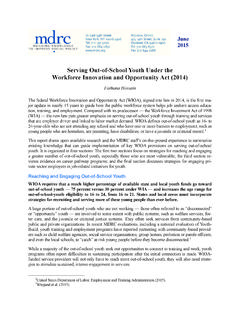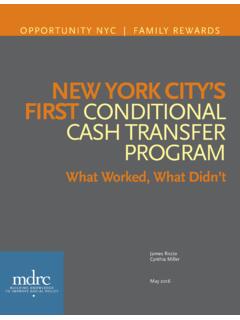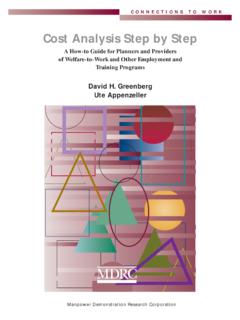Transcription of Preparing High School Students for Successful Transitions ...
1 Preparing High School Studentsfor Successful Transitions toPostsecondary Education Research and Resources for Better High issue brief is offered by the National High School Center, a centralsource of information and expertise on high School improvement issuesthat does not endorse any interventions or conduct field studies. Fundedby the Department of Education, the National High School Centerserves the Regional Comprehensive Centers in their work to build thecapacity of states across the nation to effectively implement the goals ofNo Child Left Behind relating to high schools. The National High SchoolCenter is housed at the American Institutes for Research and partners withother leading education research organizations such as Learning PointAssociates, National Center for Educational Achievement (NCEA),WestEd, and MDRC, the organization responsible for the primary authorship of this report.
2 The contents of this report were developed under agrant from the Department of Education. However, those contents do notnecessarily represent the policy of the Department of Education, and youshould not assume endorsement by the Federal Government. BRIEF AUTHORM ichael BangserMDRC August 2008 Preparing High School Studentsfor Successful Transitions toPostsecondary Education Michael Bangser of MDRCKEY ISSUES tudents high School experiencesoften do not prepare them adequatelyfor postsecondary education and theworld of work. Special attentionshould be paid to increasing the rigor,relevance, and engagement of the highschool curriculum, including for stu-dents who have traditionally facedbarriers to Successful postsecondarytransitions. Primary FindingA number of promising approachesare available to improve transitionsfrom high School .
3 However, effectiveimplementation of these approacheswill require sustained financial sup-port along with appropriate invest-ments in technical assistance andprofessional Level Align high School curricula, gradu-ation standards, and assessmentswith the expectations of postsec-ondary educational institutionsand employers. Hold high schools accountablefor increasing the percentage ofgraduates who complete a cur-riculum that prepares them forpostsecondary education andINTRODUCTIONIn the current information- and technology-based economy, a high schooldiploma is no longer sufficient as a terminal degree. Most of the fastest-growing jobs that pay reasonably well require at least some postsecondaryeducation1(Carnevale & Desrochers, 2003). However, due to what is oftencharacterized as a leaky educational pipeline, too many Students fail tocomplete high School and make a Successful transition to postsecondaryeducation and , almost 30% of Students do not graduate from high School witha regular diploma (Swanson, 2004).
4 Many of the Students who do graduatedecide to combine work with various forms of postsecondary educationduring a period when their career plans are still evolving (Haimson &Deke, 2003; McDonough, 2004). Whatever specific paths young peoplepursue, it is increasingly clear that the skills needed for work often mirrorthose required for admission to and success in postsecondary education(ACT, 2006; Carnevale & Desrochers, 2003).This Issue Brief reviews lessons from studies of selected policies and pro-grams designed to improve Students preparation for postsecondary path-ways. Special emphasis is placed on ways to help those who traditionally facesubstantial barriers to success, including low-income Students , AfricanAmerican and Latino Students , and Students with CHALLENGES tudents high School experiences too often fail to prepare them for post-secondary education or for the rigors of work in an consistently show that many high School graduates do not meetemployers standards in a variety of academic areas, as well as in employa-bility skills such as attendance, teamwork and collaboration, and workhabits.
5 (National Association of Manufacturers, 2005; Peter D. HartResearch Associates, 2005). In addition, many Students enter postsec-ondary education needing remedial coursework. Even when they receiveremediation, these Students are less likely to earn a degree or certificatethan Students who do not need remediation (Wirt et al., 2004).At-a-GlancePreparing High School Students for SuccessfulTransitions to Postsecondary Education s information-based work-force demands. Create governance mechanismsand financial incentives to alignK 12 and postsecondary plan-ning and budgets. Provide feedback to high schoolsby creating a system for trackingstudents across the K 12 andpostsecondary education systemsand into the workplace. Develop financial aid policies thatprovide incentives not only toattend but also to complete post-secondary and School Levels Intervene early, when Students aredeveloping their college andcareer aspirations.
6 Emphasize rigor and high expec-tations for all Students , alongwith appropriate counseling andother supports. Integrate strong academic contentinto career-focused classes. Collaborate with postsecondaryinstitutions, economic develop-ment agencies, and employers tohelp create smoother transitionsto college and the from high School to postsecondary education and employmentcan be particularly challenging for Students with disabilities. Althoughthere has been an increase in postsecondary attendance (especially at com-munity colleges) by Students with disabilities, their enrollment rate is stillwell below that of their peers in the general population. The employmentrate of Students with disabilities soon after leaving high School also remainswell below that of their same-age peers (Wagner et al.)
7 , 2006). Moreover, Students with disabilities are faced with fragmented services, limited pro-gram accessibility, and training that too often focuses on low-paying jobs(National Council on Disability, 2007). (Strategies to promote successfulpostsecondary Transitions for Students with disabilities are presentedthroughout this Issue Brief but particularly in the section beginning onpage 14.)IMPLEMENTATION LESSONS AND CHOICESV aried strategies have been implemented to prepare high School studentsfor postsecondary education and employment. Table 1 includes examplesof some specific programs; however, this Issue Brief focuses on cross-cuttinglessons that decisionmakers should consider in tailoring programs and poli-cies to their specific state and local information can besupplemented by referring to more detailed discussions in the AdditionalResources listed at the end of this publication.
8 Preliminary Program Design IssuesThose responsible for designing policies and programs to prepare studentsfor Successful postsecondary Transitions should first address three overarch-ing questions:1. When should the intervention start?Interventions that begin in the jun-ior or senior year can be too late certainly for those Students who havealready dropped out but also for those who have aspirations for postsec-ondary education but have not passed the required courses. By beginningearlier, it is possible to engage Students when they should be developinginitial postsecondary education and career aspirations accompanied by anappropriate academic plan (McDonough, 2004). Students need to pass core ninth-grade courses in English, math, science,and social studies if they are to remain on track for high School graduation(Allensworth & Easton, 2005; Schneider, 2006).
9 If Students do not passkey gatekeeper courses such as Algebra I on time, it can be difficult tocomplete the full sequence of coursework needed for postsecondary educa-tion, particularly in 4-year colleges (Paul, 2005; Schneider, 2006). Studentsmust understand the importance of taking and passing the early courses,and schools must provide sufficient access to these courses along with thenecessary supports to help Students pass 1 Characteristics of Selected Interventions To Promote Successful Transition to Postsecondary Education andEmploymentDual-Credit ProgramsExamples:Dual enrollment Courses are taken in high School that are equivalent to those taken at a postsecondary institution. Credit is awarded on both the high School transcript and the transcript of the sponsoring postsecondary college high schools Students earn up to an associate s degree or 2 years of credit toward a baccalaureate degree while in high School .
10 The middle grades are included, or there is outreach to middle-grade Students , to promote academic preparationand awareness of the Early College High School college high schools Secondary schools, usually grades 10 12, are located on or adjacent to college campuses. Students can take high School and college courses; they receive a high School diploma and can earn college Prep Combines a minimum of 2 years of secondary education with a minimum of 2 years of postsecondary educationin a nonduplicative, sequential course of study. Integrates academic, vocational, and technical instruction, and uses work-based and worksite learning whereappropriate. Leads to an associate or baccalaureate degree in a specific career and Technical Education (Under the Carl D. Perkins Career and Technical Education Act of 2006 Perkins IV) The new Act provides an increased focus on the academic achievement for career and technical education stu-dents, strengthens the connections between secondary and postsecondary education, and improves state andlocal Academies School -within-a- School structure normally serves 30 60 Students per grade from grades 9 or 10 through grade Academic and occupational curricula are combined around a career theme, such as health or business andfinance.









